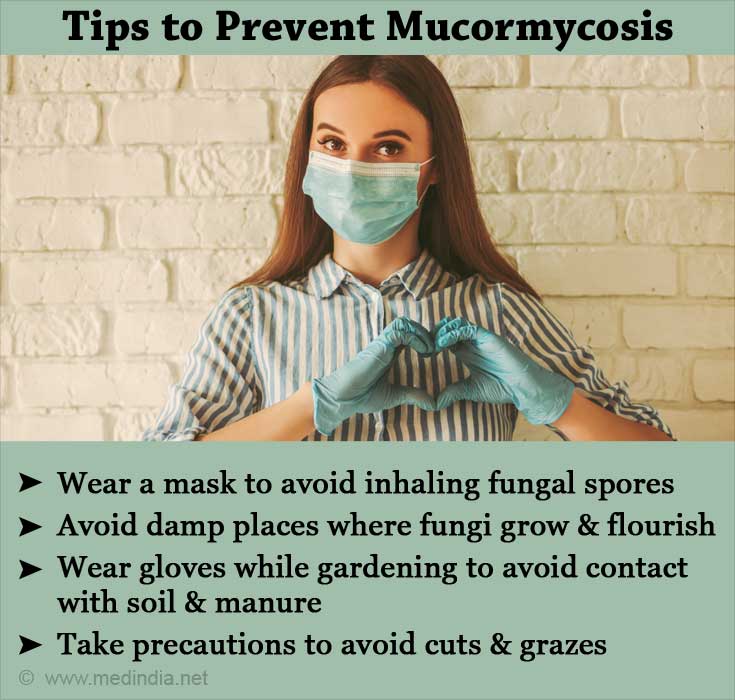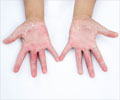- Mucormycosis - Centers for Disease Control and Prevention (CDC), Atlanta, USA - (https://www.cdc.gov/fungal/diseases/mucormycosis/index.html)
- Mucormycosis - National Organization for Rare Disorders (NORD) - (https://rarediseases.org/rare-diseases/mucormycosis/ )
- Mucormycosis (Zygomycosis) - MedicineNet - (https://www.medicinenet.com/mucormycosis/article.htm )
- COVID-19 and Mucormycosis Fungal Infection: All You Need to Know - (https://indianexpress.com/article/lifestyle/health/covid-19-mucormycosis-fungal-infection-what-to-know-7115013/)
- Doctors flag post-COVID deadly fungal infection in patients - (https://punemirror.indiatimes.com/pune/civic/docs-flag-post-covid-fungal-infection/articleshow/79767538.cms)
- Mucormycosis Statistics - Centers for Disease Control and Prevention (CDC), Atlanta, USA - (https://www.cdc.gov/fungal/diseases/mucormycosis/statistics.html)
What is Mucormycosis?
Mucormycosis, which was previously called zygomycosis, is a rare yet serious fungal infection that is very aggressive and potentially life-threatening. The disease is so called because it is caused by molds belonging to the group Mucormycetes, which are colloquially known as “black fungi”. These fungi are ubiquitous, as they are found in air, soil and decaying organic matter, including leaves, wood, and compost, among others.
Mucormycosis is difficult to diagnose, as it exhibits many different symptoms that overlap with those of other infections.
The most common infection route is through the respiratory system by breathing-in spores of these fungi, which enter the lungs and sinuses, causing serious damage. These pathogenic fungi can also enter the body through broken skin, arising from cuts, scrapes, burns, and other forms of trauma.
These infections usually attack individuals having a weak immune system (technically termed are “immunocompromised”), as a result of which they can’t fight-off the pathogen. Individuals of all ages can potentially become infected, including premature babies.
Mucormycosis is not contagious, meaning that it can’t spread from person-to-person or from animals to humans.
The major complications of mucormycosis include blindness, organ dysfunction/failure, and even death.
Epidemiology of Mucormycosis
- Disease Burden: Mucormycosis is prevalent worldwide, but the exact global burden of disease is not clear. A study conducted in San Francisco indicated that the incidence is around 1.7 per million population in the US. Moreover, it has been suggested by experts that the incidence of mucormycosis is increasing.
- Mortality Rate: A study by the Centers for Disease Control and Prevention (CDC), Atlanta, has indicated a mortality rate of 54 percent. In this context, it should be noted that the mortality rate can vary depending on the health of the patient, type of fungus, and site infected. For example, the mortality rate for disseminated mucormycosis is 96 percent, while for pulmonary and sinus mucormycosis, it is 76 percent and 46 percent, respectively.
- Reservoir: Mucormycetes are found everywhere in the environment, but most prominently in the soil. The specific environmental niches that are inhabited by these fungi vary with their genera and species.
- Transmission: These fungi can infect the body through various routes, but most commonly through inhalation of the spores from the environment. The spores can also be ingested. Hospital outbreaks have been reported that originated from contaminated bandages, tongue depressors, linen, and non-sterile medical devices, among others. Community outbreaks have been reported, which started from traumatic injuries sustained during natural disasters.
Types of Mucormycosis
There are essentially 5 types of mucormycosis, which are briefly discussed below:
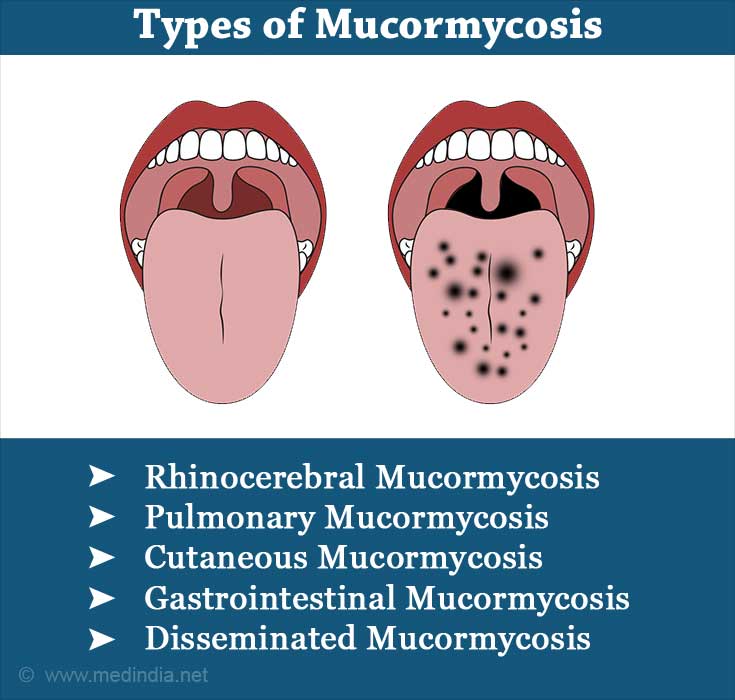
- Rhinocerebral Mucormycosis: As the name suggests, in this type of mucormycosis, the fungi enter the body through the nose and first infect the nasal sinuses, and then spread to the brain. It usually occurs in patients suffering from diabetes, cancer and those who have undergone renal, stem cell, or solid organ transplantation.
- Pulmonary Mucormycosis: This type of mucormycosis attacks the lungs and is the most common form in patients suffering from blood cancer or severe neutropenia (low neutrophil count) and those who have undergone transplantation.
- Cutaneous Mucormycosis: This type of mucormycosis affects the skin. In this case, the fungi enter the body through a crack in the skin, arising from cuts, scrapes, grazes, burns and other types of skin trauma. It is most common among people whose immune systems are strong and fully functional.
- Gastrointestinal Mucormycosis: This type of mucormycosis affects the digestive tract and is more prevalent in young children than adults. Premature and low birth weight babies less than 1 month of age are especially vulnerable, as their immunity is too weak to fight-off infections.
- Disseminated Mucormycosis: In this type, the infection spreads throughout the body via the bloodstream. The infection usually attacks the brain, but can also target other organs, including the spleen, heart, and skin. It usually occurs in neutropenic patients having a lung infection.
What are the Causes of Mucormycosis?
Mucormycosis is caused by a group of fungi known as Mucormycetes, which are present almost everywhere in the environment. These fungi belong to the Order Mucorales and the most common ones that cause mucormycosis, include Rhizopus and Mucor species.
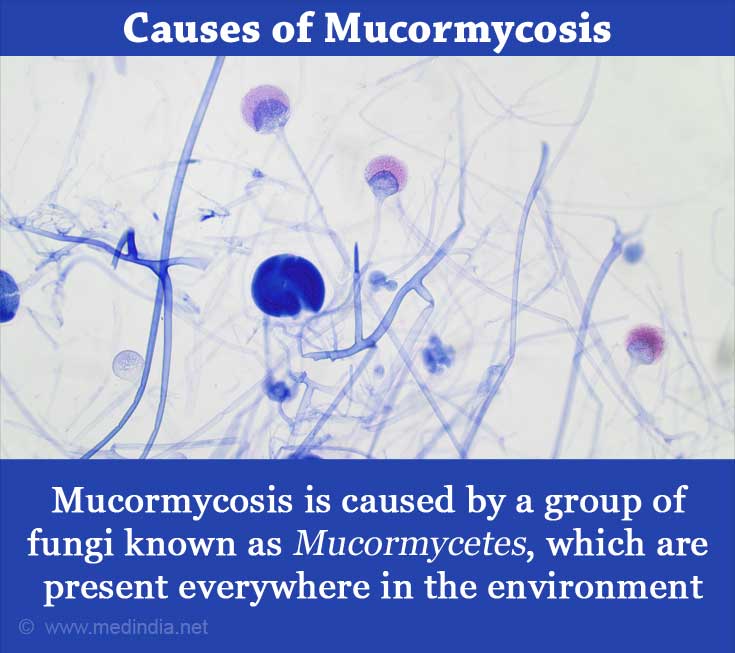
Other, less common varieties include Rhizomucor species, Cunninghamella bertholletiae, Syncephalastrum species, Apophysomyces elegans, Saksenaea vasiformis, and Lichtheimia corymbifera. These fungi are especially found in soil, within decaying organic matter, including compost, animal dung, and leaves. These fungi are more prevalent during the summer and autumn, than in winter and spring.
Disease transmission is mediated by the spores of these fungi. Since these microscopic spores are ubiquitous, it is almost impossible to avoid them. Most people remain unaffected. However, those who have a weak immune system (immunocompromised) are more prone to getting infected. If these individuals breathe-in the spores, their respiratory system becomes infected, and the infection can subsequently spread to other parts of the body.
What are the Symptoms and Signs of Mucormycosis?
The symptoms and signs depend on the type of mucormycosis, which in turn depends on the site of infection. These are briefly highlighted below:
Rhinocerebral Mucormycosis
- Swelling on one side of the face
- Fever
- Headache
- Blocked nose
- Black patches on the nose and upper inner side of the mouth
Pulmonary Mucormycosis
- Fever
- Cough
- Chest pain
- Breathlessness

Cutaneous Mucormycosis
- Blackened skin patches
- Blistering
- Ulceration
- Pain
- Redness
- Swelling
Gastrointestinal Mucormycosis
- Abdominal pain
- Nausea
- Vomiting
- Gastrointestinal bleeding
Disseminated Mucormycosis
- Widespread diffuse symptoms that are difficult to distinguish
- Brain infection can lead to mental disorders and even coma
Who are at High Risk of Acquiring Mucormycosis?
The following categories of people are at high risk of acquiring mucormycosis:
- Diabetics
- Cancer patients
- Organ / stem cell transplant patients
- People with low neutrophil count
- Patients on long-term steroids
- Injecting drug users
- People with skin injury (burns, cuts, scrapes, wounds)
- Premature / low birth weight babies
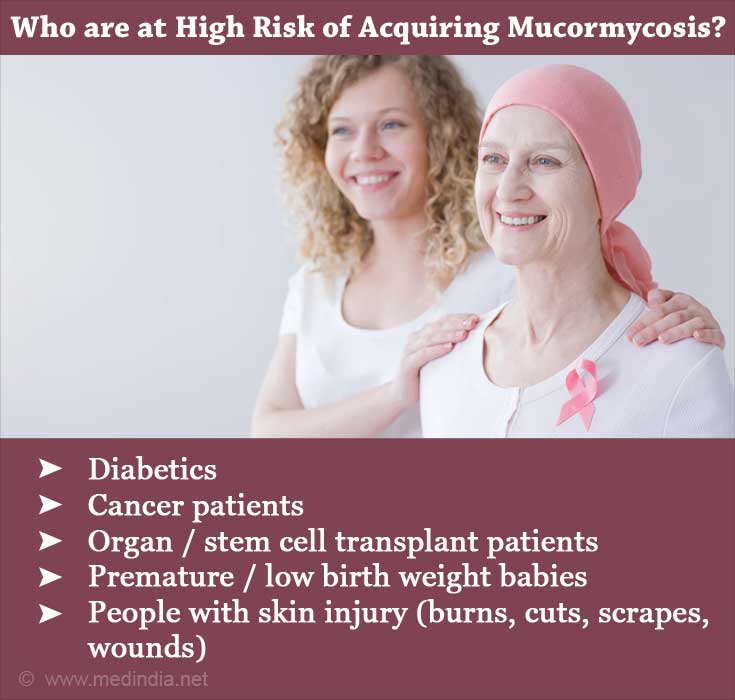
Why is Mucormycosis Increasing in COVID-19 Patients?
Mucormycosis cases and deaths have been reported during the ongoing COVID-19 pandemic from several cities in India, including Ahmedabad, Mumbai, and Delhi. The underlying reason for the occurrence of mucormycosis in COVID patients is the use of steroids for dampening of the immune response (immunosuppression).
Steroid treatment helps to suppress the overactive immune system, which otherwise leads to lung damage through a phenomenon called “Cytokine Storm” – a cardinal feature of severe COVID disease. However, the negative side of steroid therapy is that it makes these immunocompromised patients more susceptible to opportunistic infections, including Mucormycetes infections, which cause mucormycosis.
How is Mucormycosis Diagnosed?
A systematic, step-by-step approach is adopted for the diagnosis of mucormycosis, involving the following strategies:
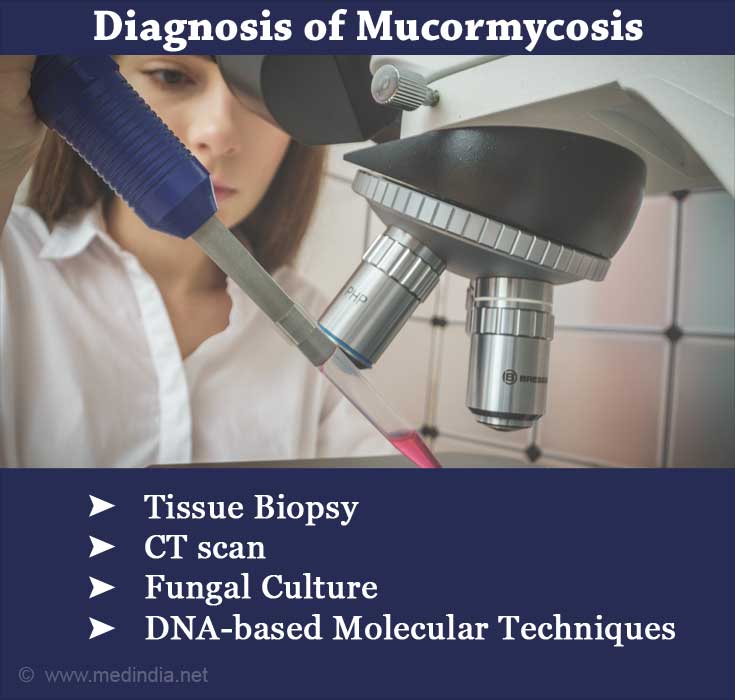
- Medical History: A detailed medical history will be taken in order to establish where and how the infection was acquired.
- Clinical Examination: A suspected case will undergo a full clinical examination of the nose and other facial structures for evidence of infection. Since the respiratory tract is the most common route of entry of the pathogen, the nose and sinuses are thoroughly examined for any black crusts and other lesions.
- Tissue Biopsy: Skin tissue biopsies can be taken if cutaneous mucormycosis is suspected. These biopsy samples are analyzed for histopathological evidence of Mucormycetes by microscopic examination.
- Imaging: Imaging techniques, such as computed tomography (CT) scans may be used to pinpoint the exact location and extent of the infection in a particular location in the body. A CT scan can be taken of the lungs, sinuses, facial structures, or any other parts of the body, where the infection is suspected to be present.
- Fungal Culture: Fluids from the respiratory tract (bronchoalveolar lavage), including sputum can be sent for culture, if pulmonary mucormycosis is suspected. Evidence of the presence of Mucormycetes in the culture fluid indicates a positive and definitive diagnosis.
- Molecular Diagnostics: DNA-based molecular techniques, such as the polymerase chain reaction (PCR) are very promising, but are still in experimental stage. These tests are not fully standardized, and have not been clinically evaluated and are currently unavailable for commercial use.
What are the Treatments for Mucormycosis?
There are essentially two main treatment modalities – antifungal therapy and surgery. Besides these, adjunctive treatment approaches and controlling the underlying immunocompromising condition, have also been suggested. These are briefly discussed below:
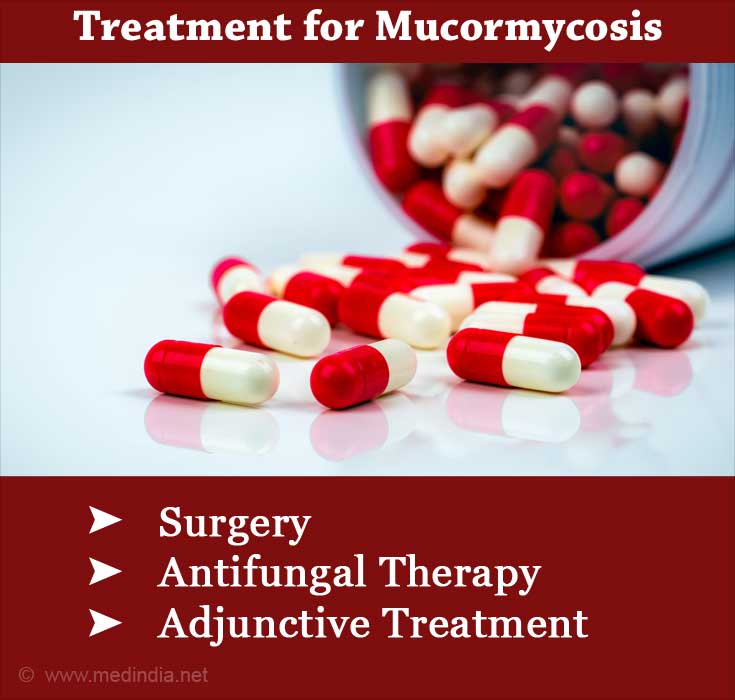
- Antifungal Therapy: Prompt administration of antifungals is vital for killing the infectious fungus and preventing it from causing further harm. This treatment needs to be timely and is of the utmost importance for improving the outcomes of patients with mycormycosis. The most effective antifungal drugs for treating mucormycosis include amphotericin B, posaconazole, and isavuconazole. While amphotericin B can only be administered intravenously (IV), posaconazole and isavuconazole can be administered both by the IV route, as well as the oral route.
- Surgery: Surgical debridement and resection of infected or dead tissue is often necessary and should be performed as soon as the diagnosis is confirmed. In case of cutaneous mucormycosis, damaged skin and associated subcutaneous tissues may also need to be surgically removed. Patients with rhinocerebral mucormycosis can exhibit significant alteration in facial appearance. Specific surgical procedures usually vary with the location, extent and severity of the infection.
- Adjunctive Treatment: Adjunctive treatment is defined as an additional treatment strategy, besides the primary treatment. Treatment with hyperbaric oxygen is one such adjunctive treatment approach. This treatment involves exposure of the patient to pressurized pure oxygen, either in a pressure chamber or through a tube. Although hyperbaric oxygen has been found to be effective for treating some types of infections, its efficacy in treating mucormycosis is still not well established. More research and large-scale clinical trials are necessary to determine the effectiveness of this adjunctive treatment strategy.
What is the Prognosis of Mucormycosis?
The prognosis or outcome for mucormycosis patients ranges from fair to poor. The mortality rate is around 50 percent but can be as high as 85 percent in case of rhinocerebral and gastrointestinal mucormycosis.
The prognosis depends on the following factors:
- Time taken for diagnosis and treatment – quicker the better
- Patient’s underlying conditions
- Site of infection
- Extent of immunosuppression
Health Tips for Prevention of Mucormycosis
Some of the strategies that can be adopted for prevention of mucormycosis, include the following:
- Wearing a mask to avoid inhaling fungal spores
- Avoiding damp places where fungi grow and flourish
- Wearing gloves while gardening to avoid contact with soil and manure
- Taking precautions to avoid cuts and grazes
